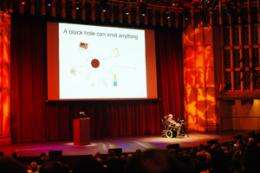Black Holes: Eternal Prisons No More, Stephen Hawking's Lecture

Celebrated physicist, Stephen Hawking, delivered an inspiring speech to a full house in Bovard Auditorium on March 10. USC College Dean Howard Gillman kicked off the event by introducing Nick Warner, professor of physics, mathematics and astronomy. Hawking was Warner’s academic adviser while he studied at the University of Cambridge.
Warner said that Hawking has contributed greatly to popularizing science with his successful book A Brief History of Time, which sold 10 million copies and focuses on black holes and the big bang theory. With a lifetime spent studying cosmology and black holes, Hawking’s scientific prowess has also been captured by Hollywood in “Star Trek,” “Futurama” and “The Simpsons” television shows.
“Hawking has completely changed the way scientists think about black holes by first showing they are real natural phenomena and then giving us remarkable new insights into how quantum theory implies that they must evaporate,” Warner said.
Hawking’s lecture focused on black holes, a term coined by American physicist John Wheeler. Hawking discussed the history of black holes beginning with British physicist John Michell in 1783, who suggested that there might be “Dark Stars” whose gravity is strong enough to trap light and prevent the stars from being seen from far away.
Two Americans, Albert Michelson and Edward Morley, proved that the speed of light is invariant and does not depend upon where it comes from. Therefore, Michell’s picture of Dark Stars is not entirely correct. Next, Albert Einstein weighed in with his theory of relativity where space and time are no longer independent entities, but rather different directions in four-dimensional space-time.
Einstein’s theory demonstrates that space-time is curved by the presence of matter. Hawking said it is like putting a heavy ball on a rubber sheet, the sheet bends and if you increase the weight of the ball then eventually, at a critical mass and size, the ball will make a bottomless hole in the sheet that particles can get into, but not out of. Stars do the same to the curving of space and time, and at a critical mass and size a star will collapse into a black hole.
From outside a black hole, you cannot tell what is inside. Hawking noted that you can throw television sets, diamond rings or your worst enemy into a black hole — he is humorous as well as brilliant. All the black hole remembers is the total mass and the state of rotation.
The boundary of a black hole is the event horizon where gravity is strong enough to pull light back. Hawking likened it to going over Niagara Falls in a canoe. If you are above the falls, you can get away if you paddle fast enough. But once over the edge you are lost, there is no way back.
Hawking also described how he discovered that particles could slowly leak out of black holes and release energy. A miniature black hole of the mass of a mountain could generate enough power to supply the world’s energy needs. However, the energy would be difficult to harness as the power could not be maintained in a power station. It would drop through the floor and end up at the center of the Earth.
Scientists have searched for miniature black holes but to no avail. Hawking said this is a pity as he would have garnered a Nobel Prize. However, if a black hole is found through the Large Hadron Collider at CERN (the world’s largest and highest-energy particle accelerator), he interjected humorously, he will get a Nobel Prize after all.
Hawking also described how black holes seem to conflict with one of the fundamental ideas of science, namely determinism: That is, given enough detail about the state of the universe at present one can predict the future and reconstruct the past. The fact that black holes can absorb matter and then emit something completely different means that black holes appear to undermine determinism. However, Hawking believes he has found a resolution in the ideas of Richard Feynman, who believes that quantum theory involves looking at all possible alternative histories.
This perspective also supports the idea that if you fall into a black hole, you may come out in another universe. If there is a large hole and if it is rotating, you may pass through it and into another universe. So, you cannot come back to our universe. Though Hawking said that he is keen on space flight, he is not willing to transport himself to another universe.
Hawking said that the message from his talk is that black holes are not the eternal prisons once thought. If you feel you are in a black hole, don’t give up. There is a way out.
Provided by USC College


















